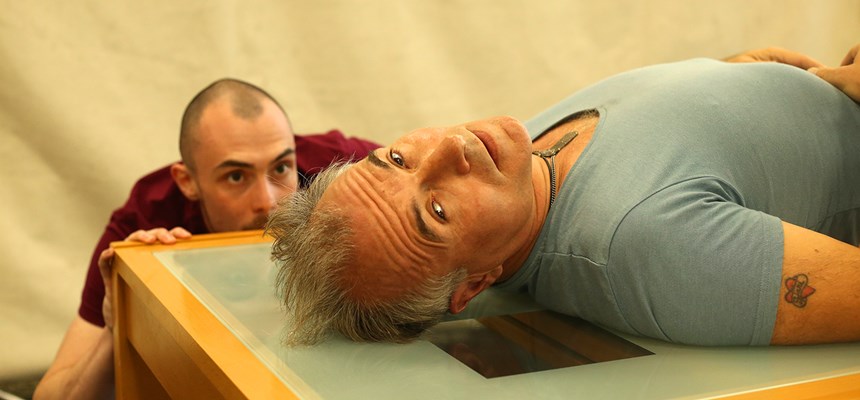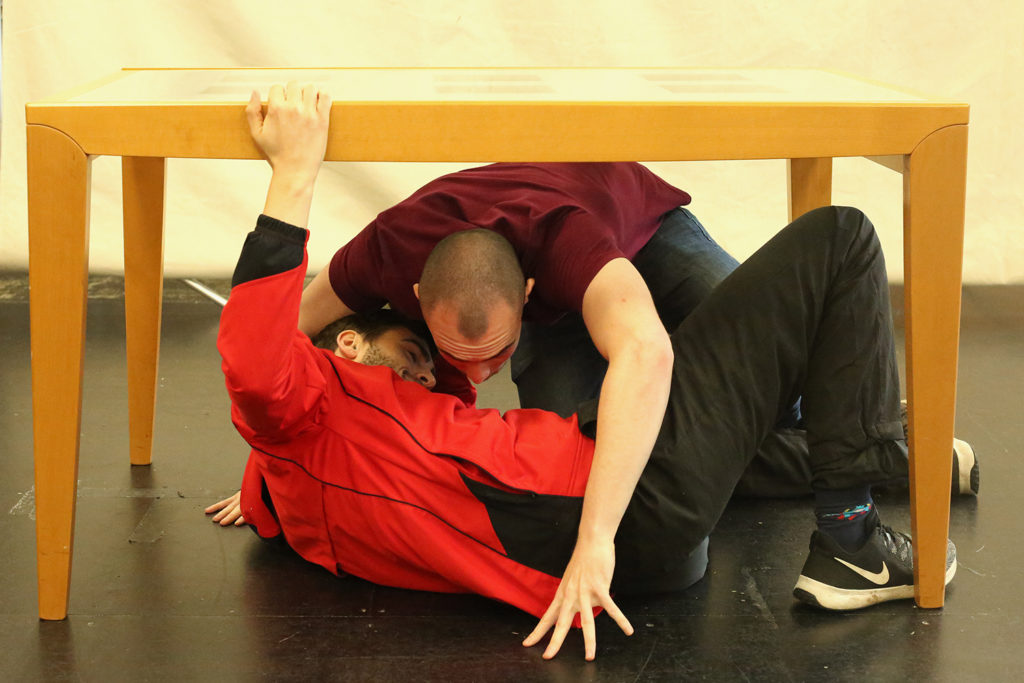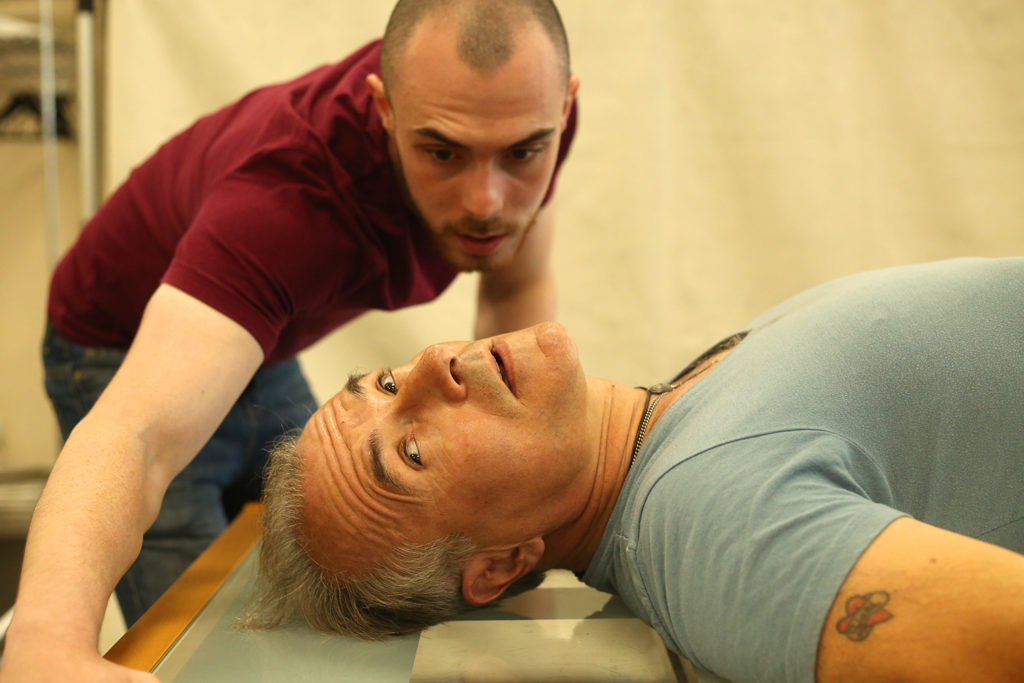
The Creature, Company of Sirens’ bold reinvention of Mary Shelley’s Frankenstein, is not only a magnificent modernisation of the classic tale but a potent and poignant examination of what it means for society to deem someone a monster. The play, vibrantly written by Lucy Gough and dynamically directed by Chris Durnall, functions as a spiritual sequel to their previous collaboration The Wolf Tattoo, which explored knife crime and gang violence. The Creature picks up these thematic threads and shifts the action from a futuristic dystopia to the dystopian prison system of our own world; to a single cell in which a young man confronts his erstwhile father for his part in the son’s terrible crime.
The production is thematically rich and harrowingly rendered. Are monsters born or created? What makes us monsters? And who is responsible? These questions form the spine of the story, and Gough has a knack for exploring the universal in the specific. The central mystery of Son’s ‘monstrous’ act is elegantly unwrapped, with breadcrumbs – bird, heart, tree – keeping the audience guessing until the final reveal, which (as in a criminal trial) still only forms a partial glimpse as to the act itself. Thematically and tonally, it called to mind Carol Ann Duffy’s Education for Leisure (empathetically exploring the psyche of a person who commits violent acts), the Taviani Brothers’ documentary Caesar Must Die (humanising/liberating prisoners through theatre), and Charles Williams’ Descent into Hell (in which the central image of hell – descending a rope into a bottomless pit – strikes a chord with the metaphors of this piece).

The original soundscape is effectively squelchy and unsettling, with Angharad Matthew’s design impressively recalling the psychological minimalism of the Sherman Theatre’s Tremor, and Dan Young’s spectral lighting eerily recalls Frankenstein’s early foray into the visual medium. The performances are powerful and evocative, even if they can be a little overwrought at times, but Durnall’s direction imbues a fantastic sense of motion and movement, and the melodrama complements the story’s high emotions and Gothic origins. Sometimes the characters’ declarations can feel a little on the nose, and a few elements don’t read as powerfully in execution as they might have on the page (the “autopsy”, Father’s revelatory monologue), but the creative team’s skill and good intentions keep the drama grounded and thrilling.
Intriguingly, the character of Son is portrayed by three actors – primarily by Matt Reed, who brings a brilliant Toby Kebbell-like intensity to proceedings, but also by Jared Ellis Thomas and Angharad Matthews, who embody the various facets of Son’s character, occupying the roles of his heart and mind respectively. The trio’s sinewy, surreal entrance starts the play: the three, a tangle of limbs under a sterile table, emerge as if from the primordial ooze in a visually thrilling sequence that you simply have to see to believe.

The doubles’ aspect of the Son character is especially interesting because duality is a key theme in his beloved Frankenstein, in which the son (the creature) can be read as a dark double of the father (Victor). Father (Jams Thomas) enters as an imposing figure jangling a set of keys. At first, then, he seems like a Warden, until his aloof disdain makes him more akin to some remote deity who materialises to pass judgment. When he enters the cell, he identifies himself as Father – not just the Frankenstinian sire of this seemingly-monstrous Son, but also the manifestation of patriarchal enmity; a symbol of the society which has shaped, condemned and discarded people like Son.
It was a pleasure to stay for the excellent post-show panel, in which the creative team explained that, in developing The Creature, they collaborated with young offenders from Parc Prison in Bridgend – the vivid authenticity of their collective and individual voices lends the drama a tangible, believable quality even as the weirdness escalates. Much of what we witness is ambiguous, largely psychological, and steered by an unreliable narrator who leaves us in doubt as to whether what we have seen actually takes place in reality.
The play is not realistic in a literal sense, then, but in an emotional one. The feelings are raw and jagged; tension simmers and rises to boiling point, but there is no relief or release – because this is a snapshot into the mind of someone like Son, whose traumas are absorbed so deeply into his psyche that he relives them on an endless loop. Son’s nightmare – ‘I’m in a labyrinth being chased by a monster, but the monster is me’ – demonstrates a remorse that he never clearly vocalises, and it’s interesting that his quest for a clean slate and father figure doesn’t turn him towards religion (despite wearing a rosary, something which is never overtly mentioned by the characters). The play also has some fascinating meditations on gender/gendered violence which similarly harken back to its Shelleyan source.

The dialogue is frequently interspersed with songs by cult music icon Daniel Johnston, a loner and underground revolutionary of whom Nirvana’s Kurt Cobain was a vocal admirer. The most striking of these is ‘Casper the Friendly Ghost’, which hauntingly sketches Son’s predicament through the recurring lyric, ‘he was smiling through his own personal hell’. The penal system is its own specific type of hell on earth, imprisoning people in a monotonous cycle that is supposed to squeeze the criminal impulses out of them and depositing them back into society a changed person – or, otherwise, hole them up for the rest of their natural-born lives for committing a crime that society deems unforgivable. But it is almost impossible to imagine how the four walls of a barren cell can facilitate a moral and spiritual metamorphosis, especially because a criminal record can operate as an indelible mark on one’s character which jeopardises the prospect of ever finding a stable job, home, and life.
‘Am I to be thought the only criminal, when all human kind sinned against me?’ Though never spoken in this version, the original creature’s plaintive repine appears to encapsulate Son’s rationale. Myriad social factors and personal traumas formed the disparate limbs of his identity that the root of his criminal actions is fragmented in neglect, abandonment, isolation, and (implicitly) issues of poverty, class and mental health. Monstrosity is a social phenomenon; it’s a word we use to label people whose actions are so repugnant that we as a society cannot condone. But monsters are the children of society – and, as Son urges Father, the responsibility for these monstrous acts are shared by us all. If society does not provide an opportunity for people to change, the vicious cycle repeats. The fact that re-offending is on the rise and people of colour (and especially black men) are disproportionately incarcerated accords with the notion that prison is a microcosm for the world: its injustices are the world’s injustices. The system punishes the offender rather than the social structures which contributed to that person’s crime, and as such can arguably never truly offer justice or closure.
The least we can do, as Son implores, is listen. The play wonderfully demonstrates how literature (and theatre) can help you make sense of the world – Frankenstein’s creature gives Son the words he wouldn’t otherwise have to describe the chaos in his soul. Likewise, this production gives us the chance to hear Son’s story and empathise with him just as we did with Shelley’s creature.
This is a four-star show with a five-star heart that resonates long after the striking final image. It’s not only a taut exercise in maintaining mystery and suspense, but a viscerally timely and harrowingly relevant work of art that urges us to take responsibility for what we create and, crucially, for each other. The Creature is playing at Seligman Theatre, Chapter Arts Centre from 1-5, 8-10 October (BSL-interpreted performance on 4 October): https://www.chapter.org/whats-on/performance/the-creature-company-of-sirens/4595/.

1 thoughts on “Review ‘The Creature’, Company of Sirens, Chapter Arts Centre, by Barbara Hughes-Moore”
-
Pingback: 2020 Vision: Updates and Future Plans – The Law Lass
Get The Chance has a firm but friendly comments policy.